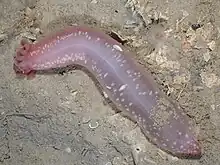Chiridota heheva
Chiridota heheva is a species of sea cucumber in the family Chiridotidae. The species is known from deeper regions in the Western Atlantic Ocean, but has a cosmopolitan distribution. It was described by Pawson and Vance in 2004.[1][2][3] It occupies all three types of chemosynthetic ecosystems; hydrothermal vents, cold seeps, and organic fall. Unlike many other animals in similar environments, they do not host chemosynthetic bacteria.[4]
| Chiridota heheva | |
|---|---|
 | |
| Scientific classification | |
| Domain: | Eukaryota |
| Kingdom: | Animalia |
| Phylum: | Echinodermata |
| Class: | Holothuroidea |
| Order: | Apodida |
| Family: | Chiridotidae |
| Genus: | Chiridota |
| Species: | C. heheva |
| Binomial name | |
| Chiridota heheva Pawson & Vance, 2004 | |
References
- "WoRMS - World Register of Marine Species - Chiridota heheva Pawson & Vance, 2004". www.marinespecies.org. Retrieved 2022-08-06.
- Pawson, David L.; Vance, Doris J. (2004-06-11). "Chiridota heheva, new species, from Western Atlantic deep-sea cold seeps and anthropogenic habitats (Echinodermata: Holothuroidea: Apodida)". Zootaxa. 534 (1): 1. doi:10.11646/zootaxa.534.1.1. ISSN 1175-5334.
- New evidence for a cosmopolitan holothurian species at deep-sea reducing environments
- The genome of an apodid holothuroid (Chiridota heheva) provides insights into its adaptation to a deep-sea reducing environment
This article is issued from Wikipedia. The text is licensed under Creative Commons - Attribution - Sharealike. Additional terms may apply for the media files.